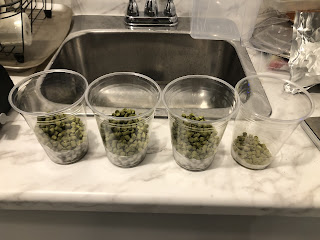Tasting notes:
Smell: Big malt character pops out with milk chocolate and dark fruit (plum and raisin). The roast and fruit characters are probably a little higher than desired and mostly over power the more subtle bread and crust character from the Munich and Vienna malts. A touch of alcohol comes through as it warms. No hop or yeast derived aromas.
 Appearance: Dark brown with nice garnet tints, especially in the light. Fairly clear but has a touch of haze that makes it seem darker. Head is small and off white and quickly fades to a ring of small bubbles.
Appearance: Dark brown with nice garnet tints, especially in the light. Fairly clear but has a touch of haze that makes it seem darker. Head is small and off white and quickly fades to a ring of small bubbles.
Taste: Up front there’s a big sweet bread crust-like malt character but this quickly shifts toward a more roasty chocolate and burnt sugar character. Finish had notes of dried fruit and moderate bitterness that blends with the roast character to give a bittersweet chocolate impression. No hop character other than the bitterness.
Mouthfeel: Moderately carbonated and fairly full bodied. Alcohol is not hot but does give a warming sensation over time.
Overall: While not an overly bad beer this is probably the worst of the doppelbocks I’ve made. The roast character seems stronger than in past batches and overshadows the other characters of the beer. While this one seemed to have some rough, near metallic, off flavors when first kegged the additional time at cool temperatures and carbonation seem to have rounded them out. While I was excited to get the 30L dark Munich malt I think it was overwhelmed by using so much Caramunich, especially with the pale chocolate malt also in the mix and I will probably only use a quarter pound of each of those in my next attempt at this style. The failure to set my mill correctly and try to correct it by adding malt extract was also a mistake as it meant there was less of the Munich malt character in the end product to balance the roast and caramelized flavors.
8/19/22
Made a starter from a mason jar of yeast previously used on a Helles and a Pilsner. First time using this 2L Erlenmeyer flask and first time using a stir plate in a long time but both seem to work well. The starter should have been created a few days earlier for maximum viability but this should provide some increase to the amount of yeast available and provide vitality to the yeast already in the mix.
8/20/22
Brewday
Forgot to adjust my mill setting until half way through milling which led to undercrushing and low efficiency. I also added too much sparge water and ended up with ~7.5 gallons pre-boil. Between both of these I ended up with a pre-boil gravity ~1.040 which is no where near what was expected. In order to resolve these issues I did a 2 hour boil and added a pound of dry malt extract. Despite both of these adjustments the post-boil gravity was still only 1.066, a ways short of the planned 1.072 and more in the middle of the Dunkles Bock range than the low end of the the Doppelbock range as intended.
Hops were split between a first wort addition that was boiled the full 2 hours and a later addition that was boiled for only 45 minutes.
After cooling to 80F the wort was transferred to a plastic carboy and placed in the chest freezer at 50F.
8/21/22
Approximately 18 hours after putting the wort in the chest freezer I shook the carboy to oxygenate and pitched the yeast starter from the stir plate.
8/22/22
Almost 24 hours since pitching it isn't show any real signs of fermentation so I increased the temperature slightly to 52F.
8/23/22
Fermenting strongly.
8/24/22
Fermentation seems to be slowing slightly so I increased the chest freezer temperature to 62 for a diacetyl rest.
8/26/22
Still fermenting, increasing the temperature seems to have kicked it back up a bit. Hopefully this will be able to get rid of any diacetyl without producing esters.
8/29/22
No signs of fermentation at this point. Began cooling off by lowering to 55F. Will continue decreasing temps for a few days until it gets down to lagering range.
9/28/22
I got a terrible sinus infection that hit me hard for nearly a month and took very poor notes during this time. The beer was eventually lagered, then kegged only to have my CO2 tank kick. 2 CO2 tanks later (I setup another one while still sick only to find out later a different keg was leaking) it is finally carbonated and starting to taste close to expectations.
9/29/22
Tasting above.
12/29/22: This batch kicked after adding a 1/2 gallon to a growler and drinking/dumping the remaining ~1/2 gallon. This one got pretty mixed reviews, no real complaints (other than one person saying it was watery(?) and it received a few strong compliments but very few people went back for a second pour and I rarely found myself choosing to reach for it during the 3+ months it spent on tap. I’m interested in rebrewing this with less character malts and a greater eye toward yeast health and fermenting temperatures but that likely won’t be any time soon.




































